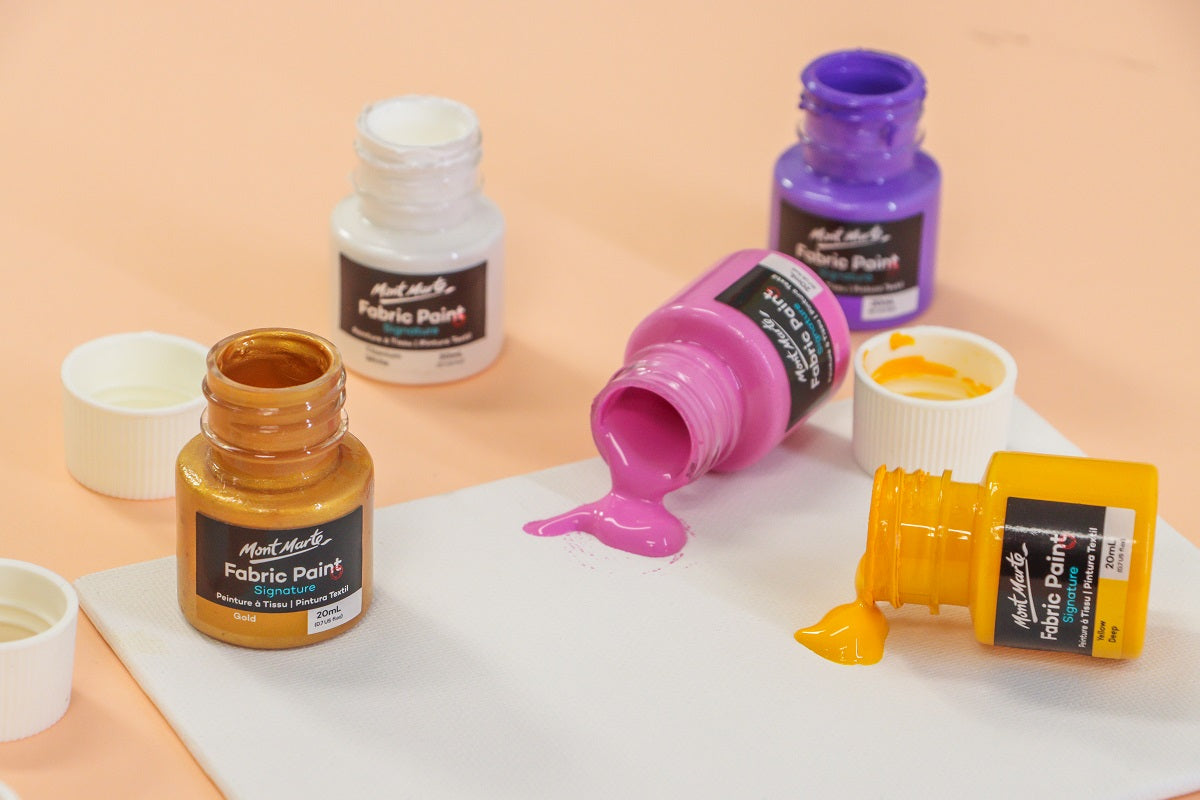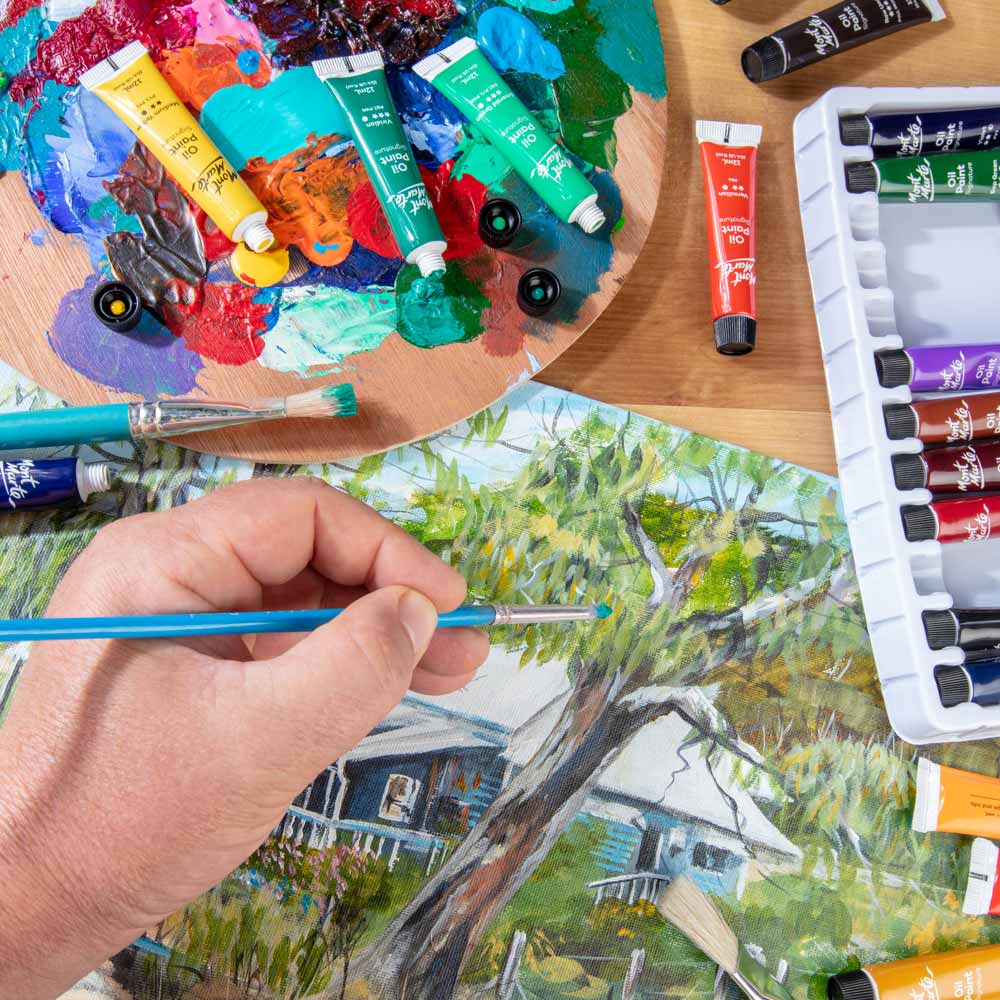Fabric paints are fun to use and a great way to add some creativity to your clothes or homewares. But don’t let them scare you, here’s 12 answers to common fabric paint questions, covering off how to use fabric paint and how to set fabric paint.

1. How to use fabric paint
There’s a variety of fun ways you can use fabric paint. From free hand painting to stencilling and stamping. Fabric paint can be used on a range of fabric surfaces like clothes, fabric shoes, tote bags, cushions, and plenty more DIY fashion and homeware projects.
For t shirts or thin fabrics, grab a piece of cardboard and place it in between the fabric to stop any paint from coming through the other side. Then dip into your paints and get creative! Once dry, place a light cloth like a tea towel or baking paper over the top of your design and iron over the top for 3 – 5 minutes. The temperature of your iron, will depend on your fabric specifications, but it’s best to aim for around 100 degrees Celsius or 212 degrees Fahrenheit to ‘fix your artwork.’
For more on how to use fabric paint, we have 10 fabric paint techniques that you can try, to get the hang of things. Or if you’re looking for more ideas, take a look at these 16 fabric paint projects.
2. What is the best paint for denim?
For denim or any dark material, we recommend painting the area you’re wanting to paint using a white fabric paint colour first. The white will catch the colours and make them ‘pop’ more on a dark surface. This step is essential if you’re planning to paint lighter colours like yellow or orange on a darker surface too. Allow this base layer to touch dry, then apply your fabric paints or draw your design over the top in pencil before painting.

3. How to get fabric paint out of clothes
Fabric paint is of course designed to stick to fabric and clothes, so it’s incredibly difficult to remove this type of paint, even before it’s had time to set. The best thing you can do is avoid getting fabric paint anywhere it might cause damage. If you’re anything like us, we reckon it’s best to paint away from carpets, curtains, couches and wear old clothes before starting your project. You might also like to lightly draw or plan your artwork in pencil before picking up the paints. A graphite pencil is fine for this – it’ll come out easily in the wash.
If you catch the paint before it’s dried to the fabric, you can try placing the fabric in warm water and immediately scrubbing with soapy water to remove.
4. How do I set fabric paint?
Each brand of fabric paint will have different instructions on how to set it. We recommend placing baking paper or a light cloth over your design and then ironing over the top for 3 – 5 minutes, according to the fabric specifications to set your design. Once ironed, wash your garment inside out on the first wash, then you’re good to go!

5. Are fabric paint projects machine washable?
Depending on your fabric, they can be machine washable. To avoid any upset, make sure you wash your project separately and wash it directly after curing to set your design in place.
6. What brush works best for fabric painting?
Taklon brushes work wonderfully with fabric painting. It’s good to reach for a synthetic brush over a natural brush as natural bristles can be damaged by the fabric medium inside the paint.

7. How long does fabric paint last?
If you take good care of your project, fabric paint can last a long time. To get the most out of your fabric paint creations, hand wash your fabric after it’s set and any time you need to, by washing with a cold, gentle hand wash and mild detergent.
8. What’s the difference between a fabric paint and a fabric marker?
Generally, the two work the same. You may find fabric markers are great for intricate work and can be easier to hold than a paint brush. However, a paint brush with fabric paint is easier for large surface areas than a marker. So, see what works for you and your project.

9. Can I mix fabric paint colours together? What about adding in acrylic?
You can mix fabric paint colours together to create more colour options, like you would with normal paint colours. You won’t need every fabric paint colour under the sun, a few primary colours will work wonderfully. You don’t need to add acrylic paint to your colours either. Fabric paint has been designed with a fabric medium inside it so the pigments can move with the fabric and sit softly. Acrylic paint will sit right on the top of the fabric and cause the fabric fibres to stiffen. If you want to avoid stiffness, don’t mix your fabrics and acrylics together.
10. How long does fabric paint take to dry?
This depends on the thickness and how many layers of fabric paint has been used, but generally it can take 30 minutes to dry. You can also speed dry the paint by using a hair dryer.

11. Does fabric paint leave a rough surface?
Fabric paint leaves a slight texture, like acrylic paint does on canvas. Unlike fabric dye which dissolves into fabric to colour it, fabric paint sticks to the top of the surface so it will have a slight texture, similar to a screen printed t shirt.
12. How do I thin fabric paint?
If you’re finding your paints are a little too thick, you can thin fabric paints with water to get it fluid and to flow to the consistency you’d like. Fabric paints are generally opaque but of course this opacity level will depend on the colour used.
Do you have more fabric paint questions? Reach out to use on socials (Instagram or Facebook), and we’ll try our best to solve it!
Ready to get creative? Check out our range of fabric paints here or get stuck into this abstract face t shirt project with fabric markers.





































